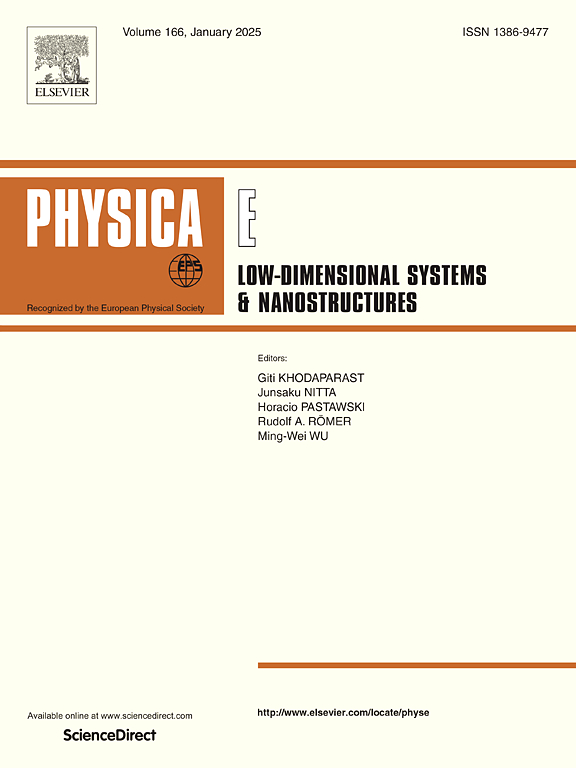Enhancing carrier mobility in two-dimensional B2Se3 through strain engineering and van der Waals heterostructures
IF 2.9
3区 物理与天体物理
Q3 NANOSCIENCE & NANOTECHNOLOGY
Physica E-low-dimensional Systems & Nanostructures
Pub Date : 2025-06-20
DOI:10.1016/j.physe.2025.116318
引用次数: 0
Abstract
Two-dimensional (2D) materials show great promise for integrated circuits due to their unique electronic properties, but enhancing carrier mobility remains a key challenge for developing high-performance devices. This study explores the external modulation of carrier mobility in 2D B2Se3 through mechanical strain and van der Waals (vdW) heterostructures. Applying 4 % strain along εx increased hole mobility from 59.45 to 36,044.72 cm2V−1s−1, attributed to reduced hole-phonon coupling and flattened energy bands near the valence band maximum. Additionally, a B2Se3/CS vdW heterostructure achieved electron mobility of 2154.08 cm2V−1s−1, up from 1227.74 cm2V−1s−1 in pristine 2D B2Se3, due to an increased elastic modulus. These findings highlight the tunability of carrier mobility in 2D B2Se3, offering new opportunities for advanced electronic and optoelectronic devices.

通过应变工程和范德华异质结构增强二维B2Se3载流子迁移率
二维(2D)材料由于其独特的电子特性,在集成电路中显示出巨大的前景,但增强载流子迁移率仍然是开发高性能器件的关键挑战。本研究通过机械应变和范德华(vdW)异质结构探讨了2D B2Se3中载流子迁移率的外部调制。沿εx方向施加4%的应变使空穴迁移率从59.45增加到36,044.72 cm2V−1s−1,这是由于空穴-声子耦合减少和价带最大值附近的平坦能带。此外,由于弹性模量的增加,B2Se3/CS vdW异质结构的电子迁移率达到了2154.08 cm2V−1s−1,高于原始2D B2Se3的1227.74 cm2V−1s−1。这些发现突出了2D B2Se3载流子迁移率的可调性,为先进的电子和光电子器件提供了新的机会。
本文章由计算机程序翻译,如有差异,请以英文原文为准。
求助全文
约1分钟内获得全文
求助全文
来源期刊
CiteScore
7.30
自引率
6.10%
发文量
356
审稿时长
65 days
期刊介绍:
Physica E: Low-dimensional systems and nanostructures contains papers and invited review articles on the fundamental and applied aspects of physics in low-dimensional electron systems, in semiconductor heterostructures, oxide interfaces, quantum wells and superlattices, quantum wires and dots, novel quantum states of matter such as topological insulators, and Weyl semimetals.
Both theoretical and experimental contributions are invited. Topics suitable for publication in this journal include spin related phenomena, optical and transport properties, many-body effects, integer and fractional quantum Hall effects, quantum spin Hall effect, single electron effects and devices, Majorana fermions, and other novel phenomena.
Keywords:
• topological insulators/superconductors, majorana fermions, Wyel semimetals;
• quantum and neuromorphic computing/quantum information physics and devices based on low dimensional systems;
• layered superconductivity, low dimensional systems with superconducting proximity effect;
• 2D materials such as transition metal dichalcogenides;
• oxide heterostructures including ZnO, SrTiO3 etc;
• carbon nanostructures (graphene, carbon nanotubes, diamond NV center, etc.)
• quantum wells and superlattices;
• quantum Hall effect, quantum spin Hall effect, quantum anomalous Hall effect;
• optical- and phonons-related phenomena;
• magnetic-semiconductor structures;
• charge/spin-, magnon-, skyrmion-, Cooper pair- and majorana fermion- transport and tunneling;
• ultra-fast nonlinear optical phenomena;
• novel devices and applications (such as high performance sensor, solar cell, etc);
• novel growth and fabrication techniques for nanostructures

 求助内容:
求助内容: 应助结果提醒方式:
应助结果提醒方式:


